Comprehensive Investigation of the Thermal Performance of an Electrically Heated Double-Glazed Window: A Theoretical and Experimental Approach
Abstract
1. Introduction
- –
- Time-varying climatic factors: changes in external air temperature, humidity, and solar radiation intensity significantly impact heat transfer;
- –
- Geometric characteristics: the size, shape, and orientation of windows affect the amount of solar radiation absorbed and heat transfer;
- –
- Frame design: the material properties and thermal insulation of window frames play a crucial role in heat transfer;
- –
- Low-emissivity coating properties: the type and effectiveness of low-E coatings significantly influence heat transfer;
- –
- Moisture condensation: condensation on glass surfaces and other structural components can alter thermal insulation and affect the overall performance of the glazing system.
2. Materials and Methods
2.1. Experimental Investigations of Heated Windows
2.2. Theoretical Studies of a Heated Window
3. Discussion
4. Conclusions
- –
- With the appearance of a heat source in the interpane space, the thermal resistance of a double-glazed unit decreases. However, by changing the location of the heater or heaters, it is possible to ensure similar temperatures of the outer and inner glass and obtain sufficiently high values of thermal resistance. The application of such solutions would be appropriate for large facades. The heat source in this case should be a low-potential source, such as solar energy, since most of the heat supplied to the heater is lost to the outside;
- –
- The studies have established that the heat source has almost no effect on the difference between the temperatures of the inner and outer glass if the heater is installed in the outer gap of the window;
- –
- Increasing the power of the heat source leads to an increase in the heat flux to the surrounding environment, but if the temperature of the source is only slightly higher than the temperature in the room, convective heat transfer, and consequently heat losses, can be minimal;
- –
- The energy radiated from the heater is also transferred to the window construction elements and into the room, which increases the efficiency of this technical solution;
- –
- The value of Nu for parallel plates with asymmetric surface temperatures is almost twice as low as that for symmetric temperatures. This effect should be considered when designing heated windows, and at the design stage, the power, size, and position of the heater should be set at which the optimal asymmetry of temperature gradients would be maintained.
Author Contributions
Funding
Data Availability Statement
Conflicts of Interest
Appendix A

References
- Jørgensen, J.D.; Nielsen, J.H.; Giuliani, L. Thermal resistance of framed windows: Experimental study on the influence of frame shading width. Saf. Sci. 2022, 149, 105683. [Google Scholar] [CrossRef]
- Simões, N.; Moghaddam, S.A.; da Silva, M.G. Review of the Experimental Methods for Evaluation of Windows’ Thermal Transmittance: From Standardized Tests to New Possibilities. Buildings 2023, 13, 703. [Google Scholar] [CrossRef]
- Tong, S.W.; Goh, W.P.; Huang, X.; Jiang, C. A review of transparent-reflective switchable glass technologies for building facades. Renew. Sustain. Energy Rev. 2021, 152, 111615. [Google Scholar] [CrossRef]
- Cannavale, A.; Martellotta, F.; Fiorito, F. Novel Technologies to Enhance Energy Performance and Indoor Environmental Quality of Buildings. Buildings 2021, 11, 303. [Google Scholar] [CrossRef]
- Cho, K.; Cho, D.; Koo, B.; Yun, Y. Thermal Performance Analysis of Windows, Based on Argon Gas Percentages between Window Glasses. Buildings 2023, 13, 2935. [Google Scholar] [CrossRef]
- Cannavale, A.; Ayr, U.; Fiorito, F.; Martellotta, F. Smart Electrochromic Windows to Enhance Building Energy Efficiency and Visual Comfort. Energies 2020, 13, 1449. [Google Scholar] [CrossRef]
- Park, S.; Song, S.-Y. Evaluation of Alternatives for Improving the Thermal Resistance of Window Glazing Edges. Energies 2019, 12, 244. [Google Scholar] [CrossRef]
- Amirkhani, S.; Bahadori-Jahromi, A.; Mylona, A.; Godfrey, P.; Cook, D. Impact of Low-E Window Films on Energy Consumption and CO2 Emissions of an Existing UK Hotel Building. Sustainability 2019, 11, 4265. [Google Scholar] [CrossRef]
- Sorooshnia, E.; Rashidi, M.; Rahnamayiezekavat, P.; Mahmoudkelayeh, S.; Pourvaziri, M.; Kamranfar, S.; Gheibi, M.; Samali, B.; Moezzi, R. A novel approach for optimized design of low-E windows and visual comfort for residential spaces. Energy Built Environ. 2023, in press. [CrossRef]
- Addonizio, M.L.; Ferrara, M.; Castaldo, A.; Antonaia, A. Air-stable low-emissive AlN-Ag based coatings for energy-efficient retrofitting of existing windows. Energy Build. 2021, 250, 111259. [Google Scholar] [CrossRef]
- Aguilar-Santana, J.L.; Jarimi, H.; Velasco-Carrasco, M.; Riffat, S. Review on window-glazing technologies and future prospects. Int. J. Low-Carbon Technol. 2020, 15, 112–120. [Google Scholar] [CrossRef]
- Nur-E-Alam, M.; Vasiliev, M.; Yap, B.K.; Islam, M.A.; Fouad, Y.; Kiong, T.S. Design, fabrication, and physical properties analysis of laminated Low-E coated glass for retrofit window solutions. Energy Build. 2024, 318, 114427. [Google Scholar] [CrossRef]
- Chen, X.; Gu, Y. Designing surface microstructure for improving energy efficiency of SiO2 glass window by infrared emission. Energy Build. 2024, 304, 113838. [Google Scholar] [CrossRef]
- Marchini, F.; Chiatti, C.; Fabiani, C.; Pisello, A.L. Development of an innovative translucent–photoluminescent coating for smart windows applications: An experimental and numerical investigation. Renew. Sustain. Energy Rev. 2023, 184, 113530. [Google Scholar] [CrossRef]
- Liu, Y.; Zhu, W.; Sang, J.; Zhang, X.; Lee, D.W.; Seo, D.S. Flexible normally transparent smart window modulating Near-Infrared penetration under ambient conditions. Adv. Mater. Interfaces 2022, 9, 2200338. [Google Scholar] [CrossRef]
- Nourozi, B.; Ploskić, A.; Chen, Y.; Chiu, J.N.-W.; Wang, Q. Heat transfer model for energy-active windows—An evaluation of efficient reuse of waste heat in buildings. Renew. Energy 2020, 162, 2318–2329. [Google Scholar] [CrossRef]
- Misiopecki, C.; Hart, R.; Gustavsen, A.; Jelle, B.P. Operating Hardware Impact on the Heat Transfer Properties of Windows. Energies 2021, 14, 1145. [Google Scholar] [CrossRef]
- Onatayo, D.; Aggarwal, R.; Srinivasan, R.S.; Shah, B. A data-driven approach to thermal transmittance (U-factor) calculation of double-glazed windows with or without inert gases between the panes. Energy Build. 2024, 305, 113907. [Google Scholar] [CrossRef]
- Vanhoutteghem, L.; Skarning, G.C.J.; Hviid, C.A.; Svendsen, S. Impact of façade window design on energy, daylighting and thermal comfort in nearly zero-energy houses. Energy Build. 2015, 102, 149–156. [Google Scholar] [CrossRef]
- Mujeebu, M.A. Nano aerogel windows and glazing units for buildings’ energy efficiency. In Woodhead Publishing Series in Civil and Structural Engineering, Nanotechnology in Eco-Efficient Construction, 2nd ed.; Pacheco-Torgal, F., Diamanti, M.V., Nazari, A., Granqvist, C.G., Pruna, A., Amirkhanian, S., Eds.; Woodhead Publishing: Sawston, UK, 2019; pp. 417–439. [Google Scholar] [CrossRef]
- Buratti, C.; Moretti, E.; Zinzi, M. High Energy-Efficient Windows with Silica Aerogel for Building Refurbishment: Experimental Characterization and Preliminary Simulations in Different Climate Conditions. Buildings 2017, 7, 8. [Google Scholar] [CrossRef]
- Abraham, E.; Cherpak, V.; Senyuk, B.; Hove, J.B.T.; Lee, T.; Liu, Q.; Smalyukh, I.I. Highly transparent silanized cellulose aerogels for boosting energy efficiency of glazing in buildings. Nat. Energy 2023, 8, 381–396. [Google Scholar] [CrossRef]
- Field, E.; Ghosh, A. Energy assessment of advanced and switchable windows for less energy-hungry buildings in the UK. Energy 2023, 283, 128999. [Google Scholar] [CrossRef]
- Ghosh, A. Investigation of vacuum-integrated switchable polymer dispersed liquid crystal glazing for smart window application for less energy-hungry building. Energy 2023, 265, 126396. [Google Scholar] [CrossRef]
- Nundy, S.; Mesloub, A.; Alsolami, B.M.; Ghosh, A. Electrically actuated visible and near-infrared regulating switchable smart window for energy positive building: A review. J. Clean. Prod. 2021, 301, 126854. [Google Scholar] [CrossRef]
- Patel, M.; Seo, J.H.; Nguyen, T.T.; Kim, J. Active energy-controlling windows incorporating transparent photovoltaics and an integrated transparent heater. Cell Rep. Phys. Sci. 2021, 2, 100591. [Google Scholar] [CrossRef]
- Gadgil, C.; Ghosh, A.; Bhattacharjee, A.; Praveen, P.L. Electrically powered active smart windows. Next Sustain. 2024, 3, 100027. [Google Scholar] [CrossRef]
- Brzezicki, M. A Systematic Review of the Most Recent Concepts in Smart Windows Technologies with a Focus on Electrochromics. Sustainability 2021, 13, 9604. [Google Scholar] [CrossRef]
- Lee, R.; Kang, E.; Lee, H.; Yoon, J. Heat Flux and Thermal Characteristics of Electrically Heated Windows: A Case Study. Sustainability 2022, 14, 481. [Google Scholar] [CrossRef]
- Cakó, B.; Lovig, D.; Ózdi, A. Measuring the effects of heated windows on thermal comfort. Pollack Period. 2021, 16, 114–119. [Google Scholar] [CrossRef]
- Kabore, M.; Michaux, G.; Ledreau, J.; Salagnac, P.; Greffet, R. Parametric study of the thermal performance of a sin-gle-family house equipped with an airflow window integrating a heated glazing. In Proceedings of the 16th IBPSA Conference, Rome, Italy, 2–4 September 2019; pp. 2019–2025. [Google Scholar] [CrossRef]
- Wang, Y.; Du, D.; Yang, X.; Zhang, X.; Zhao, Y. Optoelectronic and Electrothermal Properties of Transparent Conductive Silver Nanowires Films. Nanomaterials 2019, 9, 904. [Google Scholar] [CrossRef]
- Li, C.; Tang, H. Phase change material window for dynamic energy flow regulation: Review. Renew. Sustain. Energy Rev. 2024, 189, 113937. [Google Scholar] [CrossRef]
- Jammulamadaka, H.S.; Gopalakrishnan, B.; Chaudhari, S.; Sundaramoorthy, S.; Mehta, A.R.; Mostafa, R. Evaluation of energy efficiency performance of heated windows. Energ Eng. 2022, 119, 1–16. [Google Scholar] [CrossRef]
- Basok, B.; Davydenko, B.; Goncharuk, S.; Pavlenko, A.; Lysenko, O.; Novikov, V. Features of heat transfer through a window with electric heating. In Proceedings of the 2022 IEEE 8th International Conference on Energy Smart Systems (ESS), Kyiv, Ukraine, 12–14 October 2022; pp. 195–198. [Google Scholar] [CrossRef]
- Alain, M.; Patrick, S.; Ghislain, M.; Pierre, B. Study of Thermal Comfort and Air Diffusion Induced by a Heated Airflow Window. Available online: https://ssrn.com/abstract=4578448 (accessed on 1 December 2022).
- Michaux, G.; Greffet, R.; Salagnac, P.; Ridoret, J.-B. Modelling of an airflow window and numerical investigation of its thermal performances by comparison to conventional double and triple-glazed windows. Appl. Energy 2019, 242, 27–45. [Google Scholar] [CrossRef]
- ISO 15099; Thermal Performance of Windows, Doors and Shading Devices—Detailed Calculations. International Organization for Standardization: Geneva, Switzerland, 2003.
- Wang, Z.; Liang, J.; Lei, D.; Jiang, C.; Yang, Z.; Yang, G.; Zhang, D.; Zhang, L.; Zhang, C.; Bai, Y. Temperature-adaptive smart windows with passive transmittance and radiative cooling regulation. Appl. Energy 2024, 369, 123619. [Google Scholar] [CrossRef]
- Zhou, Z.; Fang, Y.; Wang, X.; Yang, E.; Liu, R.; Zhou, X.; Huang, Z.; Yin, H.; Zhou, J.; Hu, B. Synergistic modulation of solar and thermal radiation in dynamic energy-efficient windows. Nano Energy 2022, 93, 106865. [Google Scholar] [CrossRef]
- Zhang, R.; Li, R.; Xu, P.; Zhong, W.; Zhang, Y.; Luo, Z.; Xiang, B. Thermochromic smart window utilizing passive radiative cooling for Self-Adaptive thermoregulation. Chem. Eng. J. 2023, 471, 144527. [Google Scholar] [CrossRef]
- Wu, S.; Sun, H.; Duan, M.; Mao, H.; Wu, Y.; Zhao, H.; Lin, B. Applications of thermochromic and electrochromic smart windows: Materials to buildings. Cell Rep. Phys. Sci. 2023, 4, 101370. [Google Scholar] [CrossRef]
- Luo, L.; Liang, Y.; Feng, Y.; Mo, D.; Zhang, Y.; Chen, J. Recent Progress on Preparation Strategies of Liquid Crystal Smart Windows. Crystals 2022, 12, 1426. [Google Scholar] [CrossRef]
- Pavlenko, A.M.; Sadko, K. Evaluation of Numerical Methods for Predicting the Energy Performance of Windows. Energies 2023, 16, 1425. [Google Scholar] [CrossRef]
- Basok, B.; Davydenko, B.; Novikov, V.; Pavlenko, A.M.; Novitska, M.; Sadko, K.; Goncharuk, S. Evaluation of Heat Transfer Rates through Transparent Dividing Structures. Energies 2022, 15, 4910. [Google Scholar] [CrossRef]
- Alosaimi, F.; Almutairi, A. Heat Transfer Analysis of Double and Triple Glazed Glass Windows. In Proceedings of the 2nd International Civil Engineering and Architecture Conference, Singapore, 11–14 March 2022; Casini, M., Ed.; CEAC 2022. Lecture Notes in Civil Engineering. Springer: Singapore, 2023; Volume 279. [Google Scholar] [CrossRef]
- Koo, S.Y.; Park, S.; Song, J.-H.; Song, S.-Y. Effect of Surface Thermal Resistance on the Simulation Accuracy of the Condensation Risk Assessment for a High-Performance Window. Energies 2018, 11, 382. [Google Scholar] [CrossRef]
- Pavlenko, A.; Usenko, B.; Koshlak, A. Thermal conductivity of the gas in small space. Metall. Min. Ind. 2014, 6, 20–24. [Google Scholar]
- Lahmar, I.; Cannavale, A.; Martellotta, F.; Zemmouri, N. The Impact of Building Orientation and Window-to-Wall Ratio on the Performance of Electrochromic Glazing in Hot Arid Climates: A Parametric Assessment. Buildings 2022, 12, 724. [Google Scholar] [CrossRef]
- Elmalky, A.M.; Araji, M.T. Computational fluid dynamics using finite volume method: A numerical model for Double Skin Façades with renewable energy source in cold climates. J. Build. Eng. 2022, 60, 105231. [Google Scholar] [CrossRef]
- Bonomo, P.; Frontini, F. Building Integrated Photovoltaics (BIPV): Analysis of the Technological Transfer Process and Innovation Dynamics in the Swiss Building Sector. Buildings 2024, 14, 1510. [Google Scholar] [CrossRef]
- Basok, B.; Davydenko, B.; Pavlenko, A.M. Numerical Network Modeling of Heat and Moisture Transfer through Capillary-Porous Building Materials. Materials 2021, 14, 1819. [Google Scholar] [CrossRef] [PubMed]
- Meng, Y.; Tan, Y.; Li, X.; Cai, Y.; Peng, J.; Long, Y. Building-integrated photovoltaic smart window with energy generation and conservation. Appl. Energy 2022, 324, 119676. [Google Scholar] [CrossRef]
- Shi, S.; Zhu, N. Challenges and Optimization of Building-Integrated Photovoltaics (BIPV) Windows: A Review. Sustainability 2023, 15, 15876. [Google Scholar] [CrossRef]


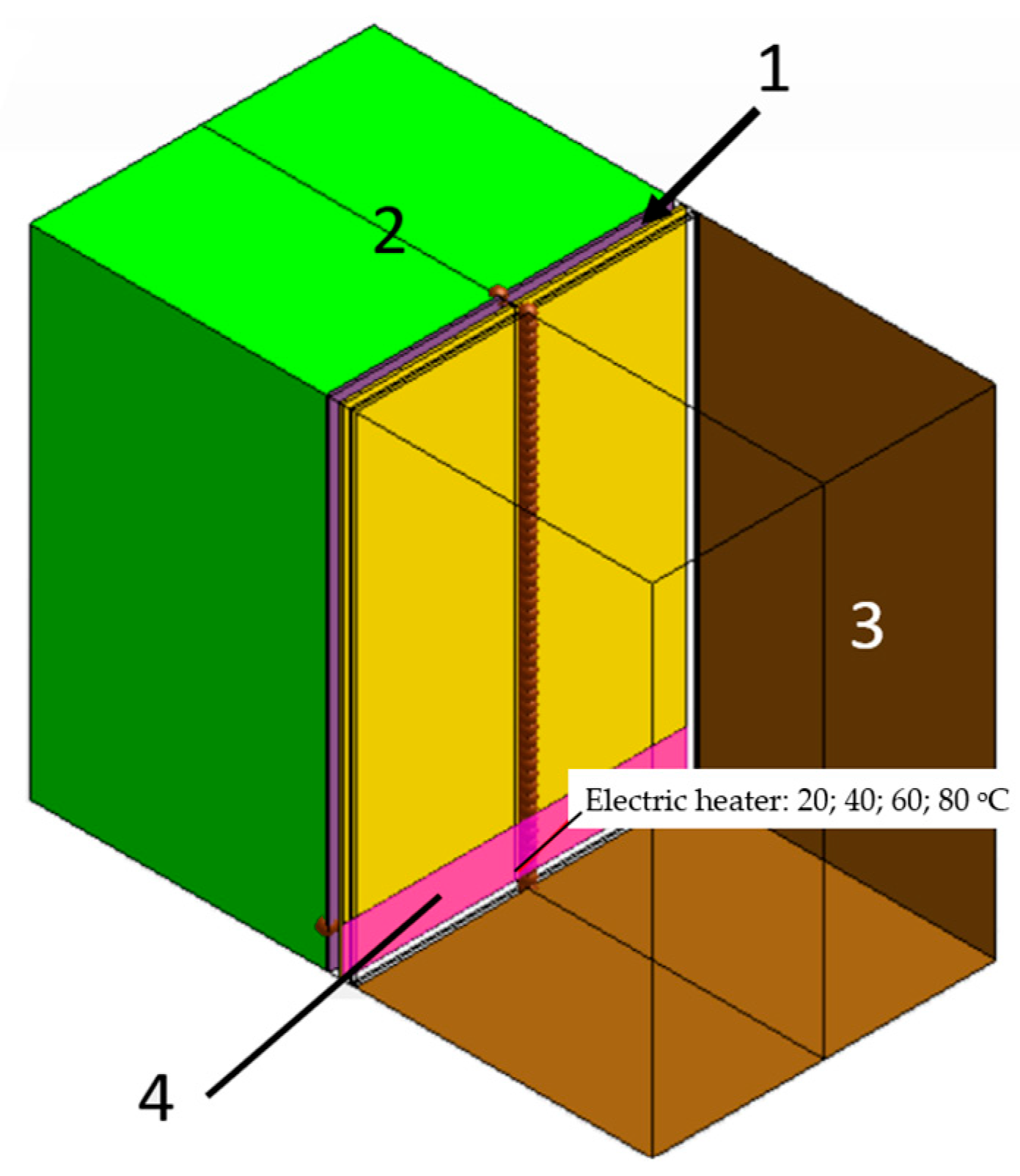
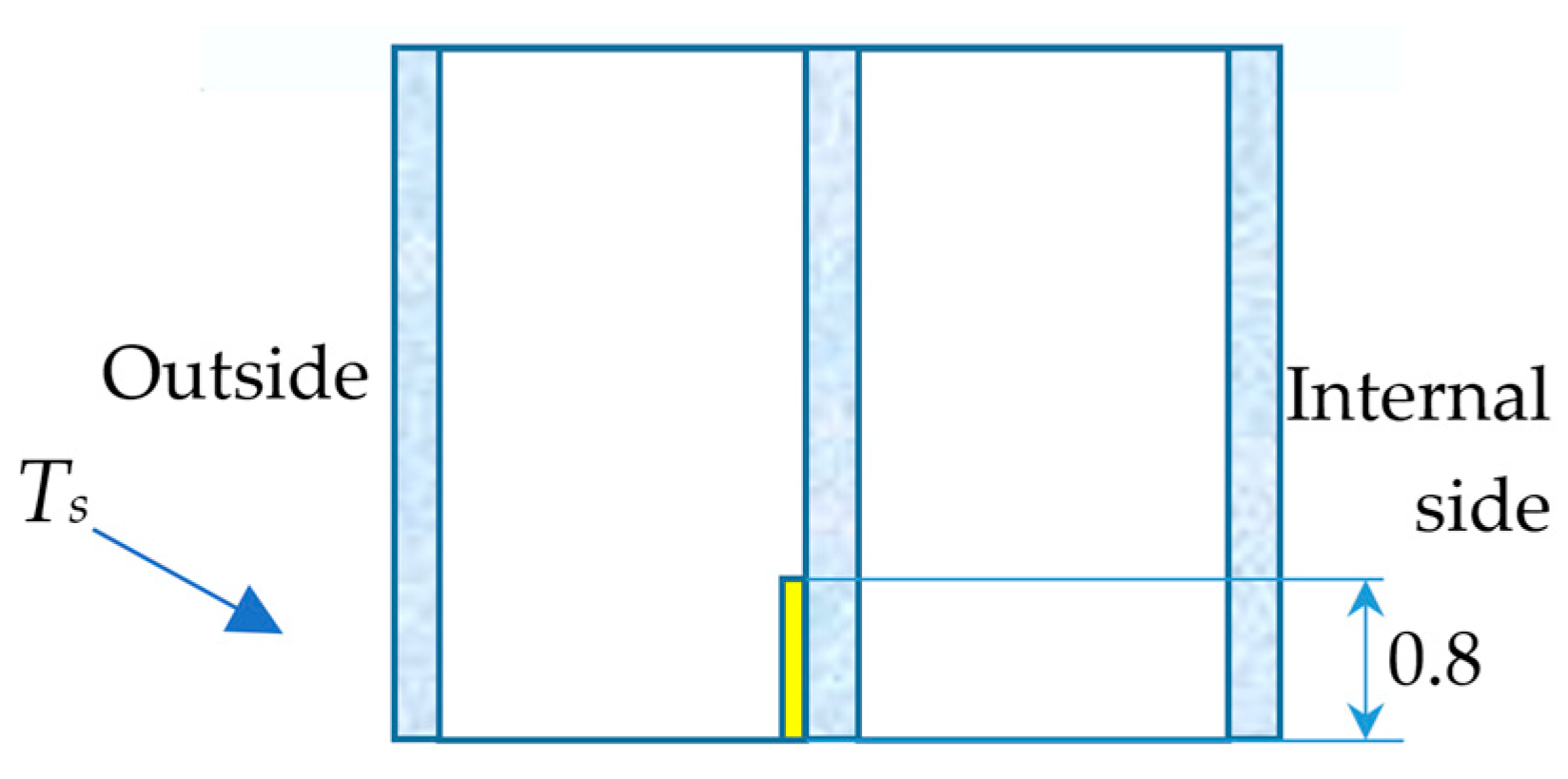

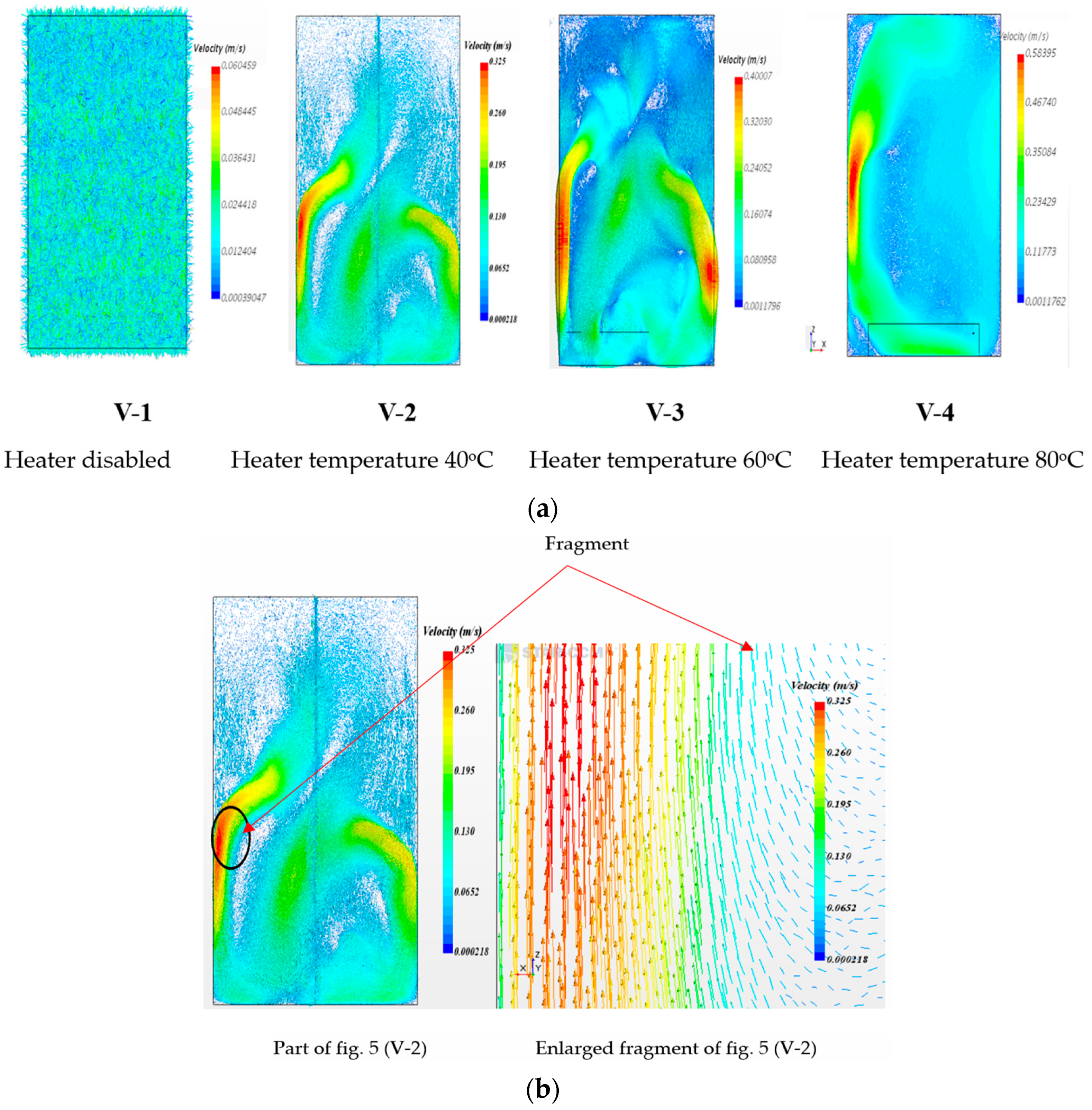
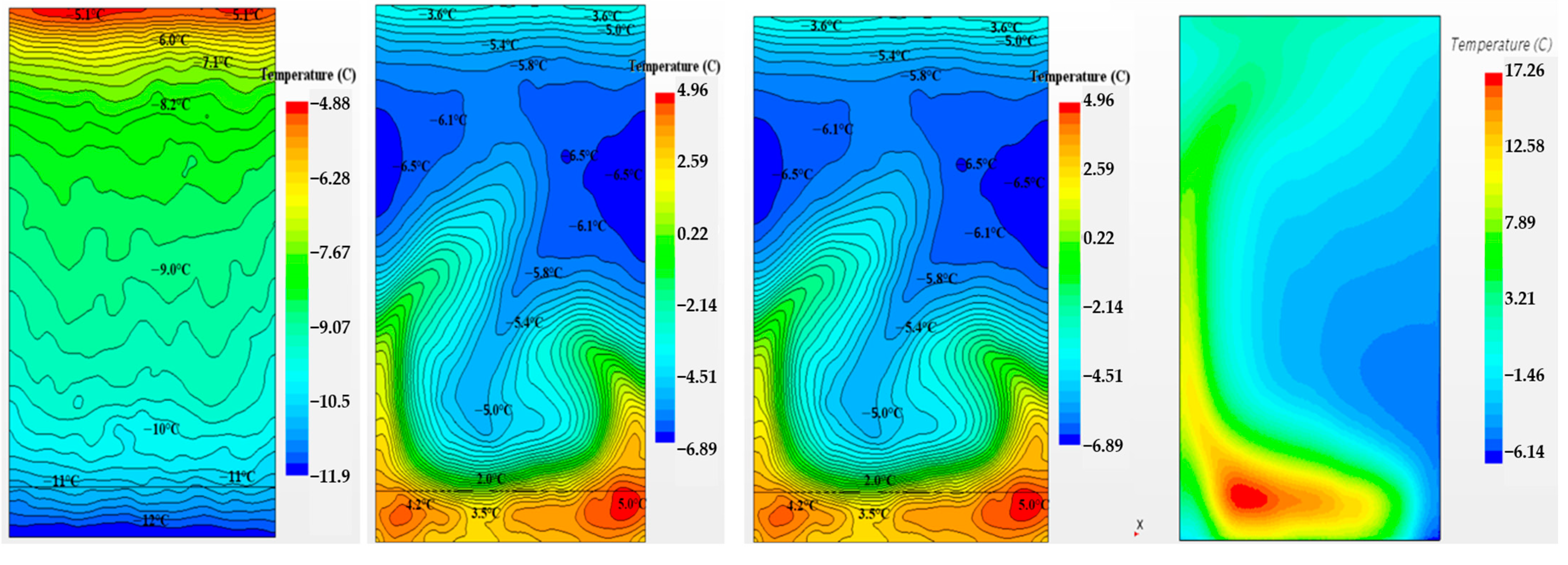
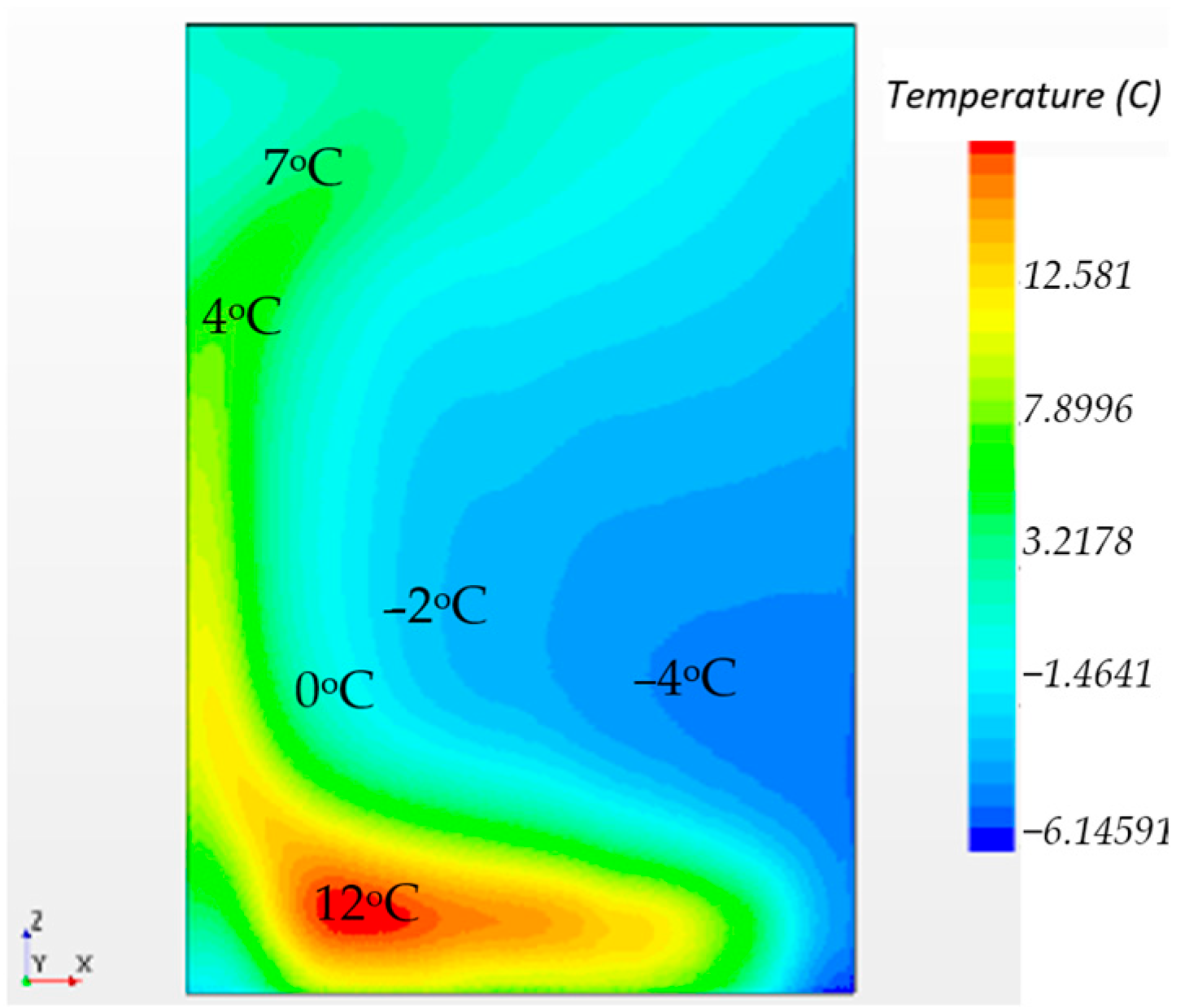
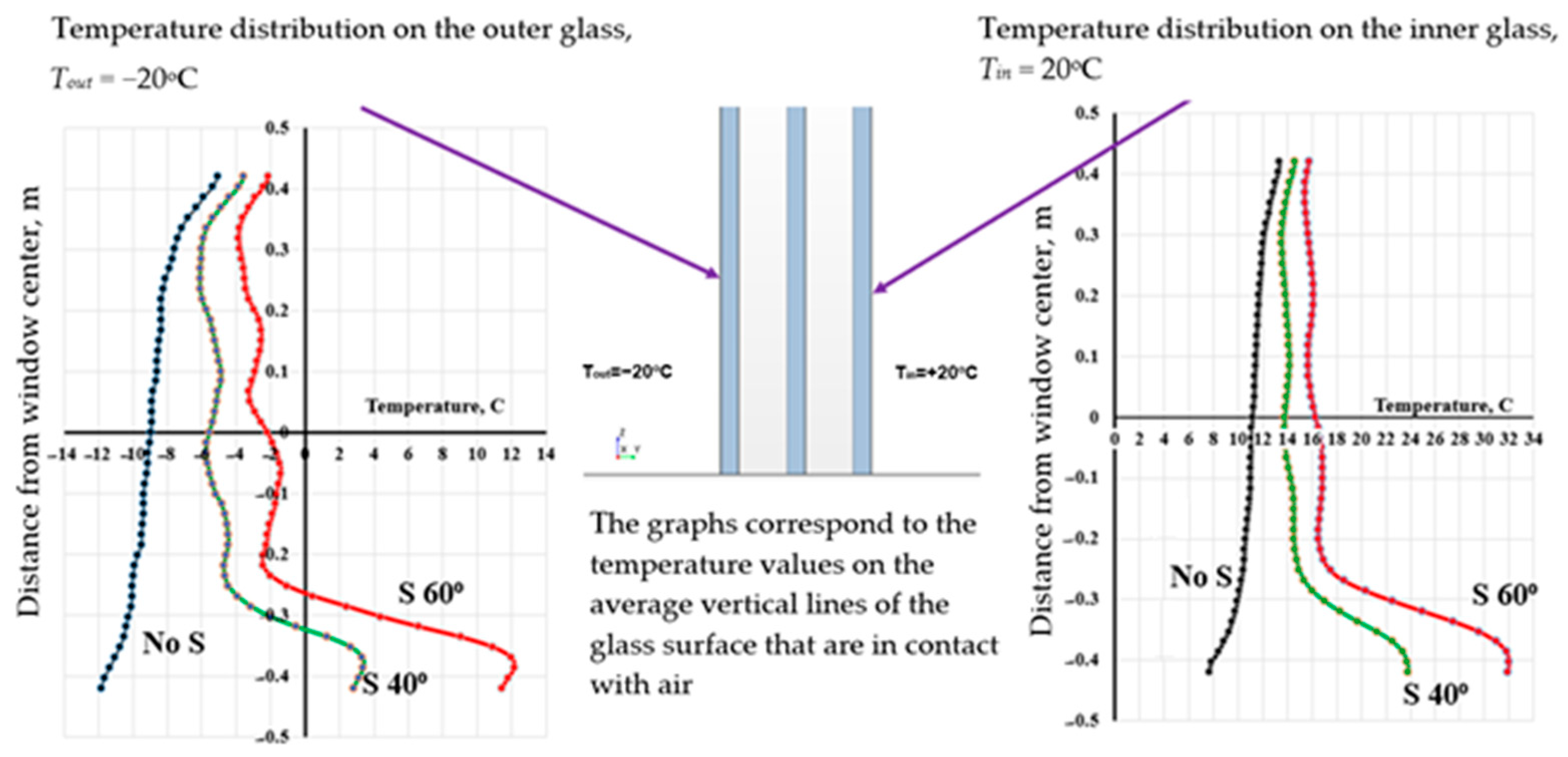


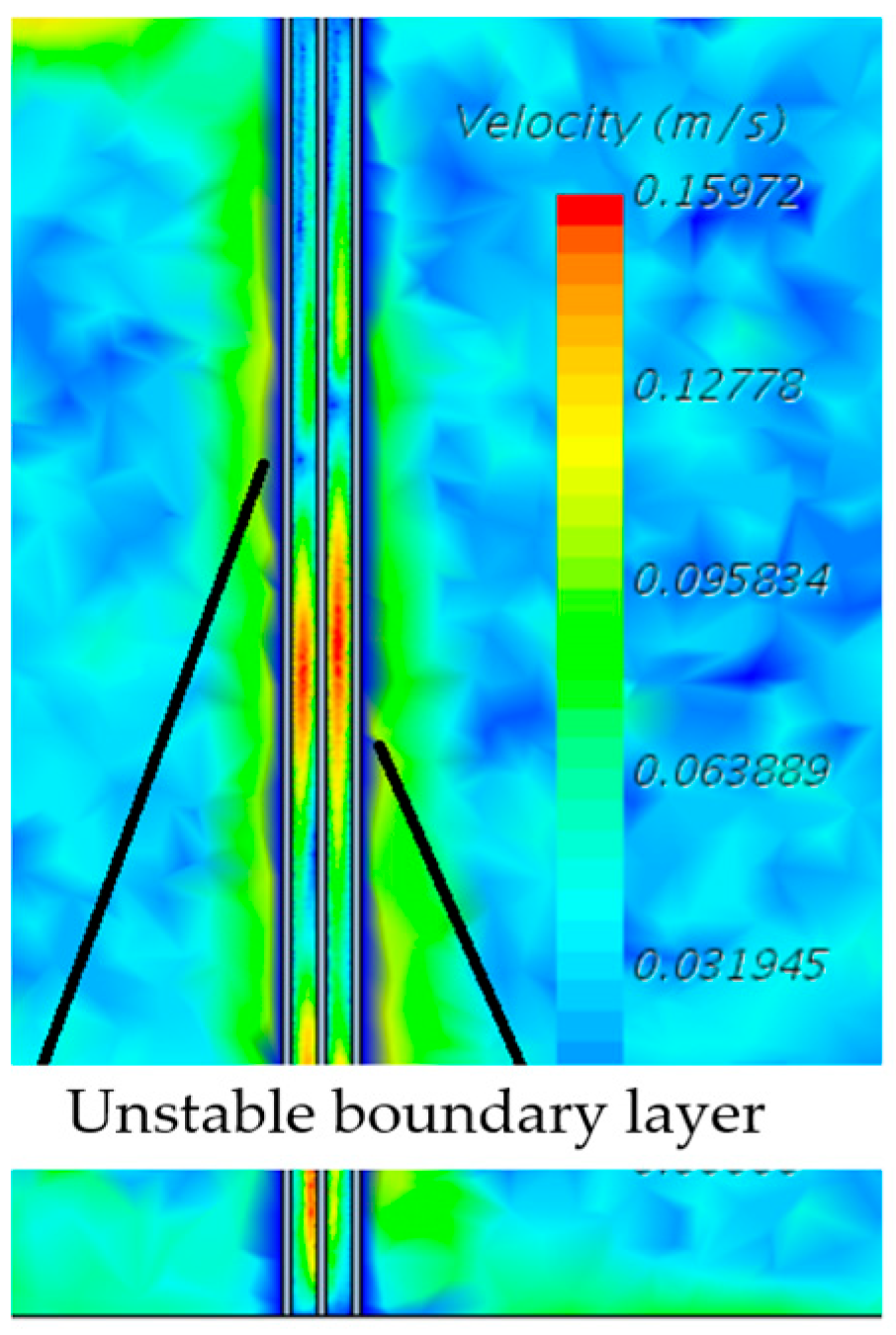
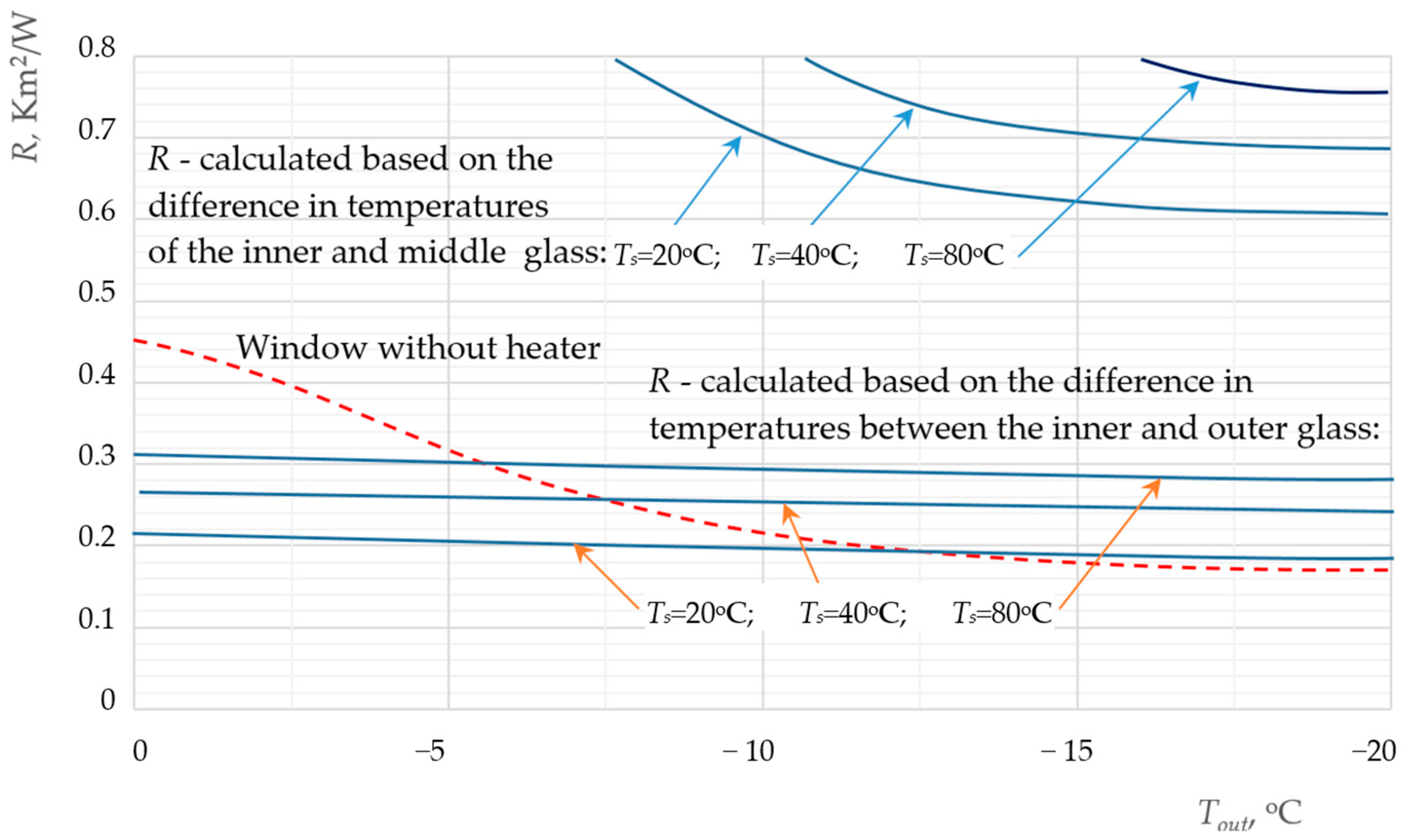
| Boundary Surface Area | Boundary Conditions |
|---|---|
| Thermal insulation conditions are set on the end surfaces of the double-glazing unit (Figure 4) | q = 0 |
| Side surfaces that restrict the air in the model, both from the warm part of the chamber and the cold part (Figure 4) | Symmetry conditions |
| On the “solid–gas” and “solid–solid” surfaces | Conditions of conjugation |
| The end surfaces of the model’s air areas: | |
| On the cold side of the chamber | –20 °C |
| From the side of the warm part of the chamber | 20 °C |
| Variant Number | Type of Window |
|---|---|
| Variant 1 (V-1) | Two-chamber window pane without a heat source |
| Variant 2 (V-2) | Two-chamber window pane, heat source at 40 °C |
| Variant 3 (V-3) | Two-chamber window pane, heat source at 60 °C |
| Variant 4 (V-4) | Two-chamber window pane, heat source at 80 °C |
| Source | V-1, No Source | V-2, Ts = 40 °C | V-3, Ts = 60 °C | V-4, Ts = 80 °C |
|---|---|---|---|---|
| Average temperature of the glass surface in contact with the warm air inside the window, Tin (°C) | 11.1 | 16.1 | 19.1 | 20.9 |
| Average temperature of the glass surface in contact with the cold air in the climatic chamber, Tout (°C) | −8.9 | −3.4 | −0.07 | 1.5 |
| Temperature difference, ΔT = Tin − Tout | 20 | 19.5 | 19.17 | 19.4 |
| Average heat flux density on the glass surface in contact with the cold air in the climatic chamber, Qout (W/m2) | 43.5 | 68 | 84 | 99.4 |
| Thermal resistance, Rterm = ΔT/Qout, (m2 K)/W | 0.460 | 0.287 | 0.228 | 0.195 |
Disclaimer/Publisher’s Note: The statements, opinions and data contained in all publications are solely those of the individual author(s) and contributor(s) and not of MDPI and/or the editor(s). MDPI and/or the editor(s) disclaim responsibility for any injury to people or property resulting from any ideas, methods, instructions or products referred to in the content. |
© 2024 by the authors. Licensee MDPI, Basel, Switzerland. This article is an open access article distributed under the terms and conditions of the Creative Commons Attribution (CC BY) license (https://creativecommons.org/licenses/by/4.0/).
Share and Cite
Basok, B.; Pavlenko, A.; Novikov, V.; Koshlak, H.; Ciosek, A.; Moroz, M. Comprehensive Investigation of the Thermal Performance of an Electrically Heated Double-Glazed Window: A Theoretical and Experimental Approach. Energies 2024, 17, 4491. https://doi.org/10.3390/en17174491
Basok B, Pavlenko A, Novikov V, Koshlak H, Ciosek A, Moroz M. Comprehensive Investigation of the Thermal Performance of an Electrically Heated Double-Glazed Window: A Theoretical and Experimental Approach. Energies. 2024; 17(17):4491. https://doi.org/10.3390/en17174491
Chicago/Turabian StyleBasok, Borys, Anatoliy Pavlenko, Volodymyr Novikov, Hanna Koshlak, Anita Ciosek, and Maryna Moroz. 2024. "Comprehensive Investigation of the Thermal Performance of an Electrically Heated Double-Glazed Window: A Theoretical and Experimental Approach" Energies 17, no. 17: 4491. https://doi.org/10.3390/en17174491
APA StyleBasok, B., Pavlenko, A., Novikov, V., Koshlak, H., Ciosek, A., & Moroz, M. (2024). Comprehensive Investigation of the Thermal Performance of an Electrically Heated Double-Glazed Window: A Theoretical and Experimental Approach. Energies, 17(17), 4491. https://doi.org/10.3390/en17174491








